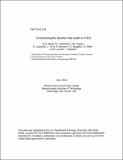Constraining the divertor heat width in ITER
Author(s)
Whyte, Dennis G.; Labombard, Brian; Hughes, Jerry W., Jr.; Lipschultz, Bruce; Terry, James L.; Brunner, Daniel Frederic; Stangeby, P. C.; Elder, D.; Leonard, A. W.; Watkins, J.; ... Show more Show less
DownloadWhyte_Constraining the.pdf (1.008Mb)
PUBLISHER_CC
Publisher with Creative Commons License
Creative Commons Attribution
Terms of use
Metadata
Show full item recordAbstract
A model is developed which constrains heat width, λr based on global power balance, momentum conservation, pedestal stability and sheath heat transmission. The model relies on measurements of the ratio of separatrix to pedestal pressure; a ratio ∼5% is found to be expected for ITER. Applying this model indicates a constraint that the allowed λr ∼ 10–30 mm for ITER if the divertor is in the high-recycling regime as expected (T < 20 eV) while a λr ∼ 1–3 mm requires a separatrix pressure approximately equal to the top pedestal pressure in violation of physical reasoning and the concept of a pedestal. A weaker constraint is applied in the model that upstream separatrix temperature simultaneously satisfies power balance. The constrained model cannot satisfy power balance with λr < 3 mm, and in order to obtain λr ∼ 5 mm requires divertor plasma temperature >100 eV, a condition which would have very negative consequences for the divertor, but has never been observed experimentally.
Date issued
2013-01Department
Massachusetts Institute of Technology. Plasma Science and Fusion CenterJournal
Journal of Nuclear Materials
Publisher
Elsevier
Citation
Whyte, D. G., B. LaBombard, J.W. Hughes, B. Lipschultz, J. Terry, D. Brunner, P. C. Stangeby, D. Elder, A. W. Leonard, and J. Watkins. "Constraining the divertor heat width in ITER." Journal of Nuclear Materials 438, Supplement (July 2013), pp.S435-S439.
Version: Author's final manuscript
ISSN
00223115